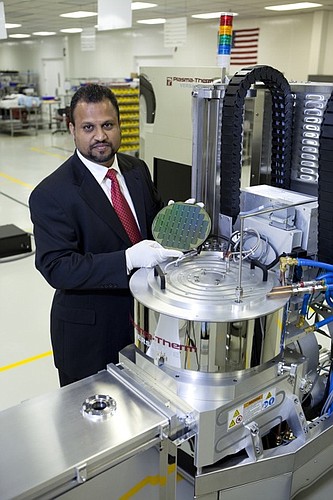The more powerful microprocessors become these days, the smaller they seem to get. For example, those used in motion-sensitive video game controllers are measured in mere millimeters, yet thousands of them can be cut from a wafer roughly the size of a 45-rpm record.
The smallness of such bigness is where Plasma-Therm LLC gets involved in the process. The St. Petersburg-based manufacturer, which dates back to 1975 and returned to private ownership last year, is seeing greater demand than ever for its machines, which are used to etch the wafers that become semiconductors going into practically every electronic gadget now on the market.
“Right now we're seeing growth in every market we serve,” says Abdul Lateef, CEO of Plasma-Therm and one of five company principals since a management buyout in January 2009. The once-publicly traded company had been owned by Swiss industrial conglomerate Oerlikon since 2000.
Plasma-Therm produces advanced plasma processing equipment used by familiar brand-name electronics companies such as Philips, Samsung and Toshiba to make semiconductors. Those chips are used in consumer goods from smart phones to HDTVs.
The machines, which can cost from $250,000 to more than $6 million, are made to customer specifications inside a “clean room” inside Plasma-Therm's headquarters at 16th Street North and 102nd Avenue. Before entering the room, employees and visitors must wear protective gear to keep loose hair or skin flecks from floating into areas where microscopic etchings occur.
Once they are completed and tested, those machines are disassembled, shipped to a manufacturer and rebuilt on site anywhere around the world by the same engineers who put them together locally. Even the finished wafers must be handled with rubber gloves to protect the product.
Most of Plasma-Therm's 85 employees have engineering backgrounds, some holding master's degrees and doctorates, and handle the company's sales and marketing, says Lateef, who started with the company as a project engineer 12 years ago. He notes that customer relations is as important at a multimillion-dollar level as it is for small companies, particularly for something as intricate as wafer-etching devices.
“It's better to have solid relations with one customer than weak relations with 10 customers,” Lateef says. The key to Plasma-Therm's equipment, he says, is to make the tiny chips its customers use work better.
Sometimes that involves being out front of a customer's project — such as designing microprocessors with even more capacity at an even smaller size and price. What works for one client can be transferred to others.
“They're developing their solutions around your product,” Lateef says. “We always learn something from every project. That knowledge never goes away.”
The return to private ownership means more revenue staying within the Tampa Bay area. That translates to greater community support by Plasma-Therm, such as sponsorship of an exhibit at the Salvador Dali Museum and participation in the Tampa Bay Technology Forum's annual CoolTech contest at the Museum of Science and Industry.
While the recession created a prime opportunity for Plasma-Therm managers to buy their company from Oerlikon, it also stymied the local company's growth. Lateef says revenue average about $50 million annually and last year was the lowest in more than a decade.
That's about to change quickly, however, with a gain of at least 70% expected this year and more growth anticipated in the next three years as demand for consumer electronics increases. Sales of Nintendo Wii gaming systems and Apple's iPhone, which utilize processors that sense motion, ultimately lead back to Plasma-Therm products.
One specific area of growth Lateef foresees is the use of solid-state LED lighting, which is used not only in computers but also for traffic signals. Advantages of the smaller lights, which can shine brighter than incandescent or fluorescent bulbs, include lower energy consumption, improved safety and better functionality during power outages.
“We've already seen double growth in solid-state lighting and the potential is magnitudes larger,” Lateef says. He points out that several U.S. cities have converted their traffic lights to LED displays and many other countries are making similar changes.
In addition to Lateef, who has a master's degree from the University of Florida, members of Plasma-Therm's management team include Andrew Raheb, CFO; Ed Ostan, executive vice president of sales and marketing; Jim Pollock, COO; and Russ Westerman, chief technology officer. Their buyout was assisted through Florida's Qualified Target Industry tax incentive program.






